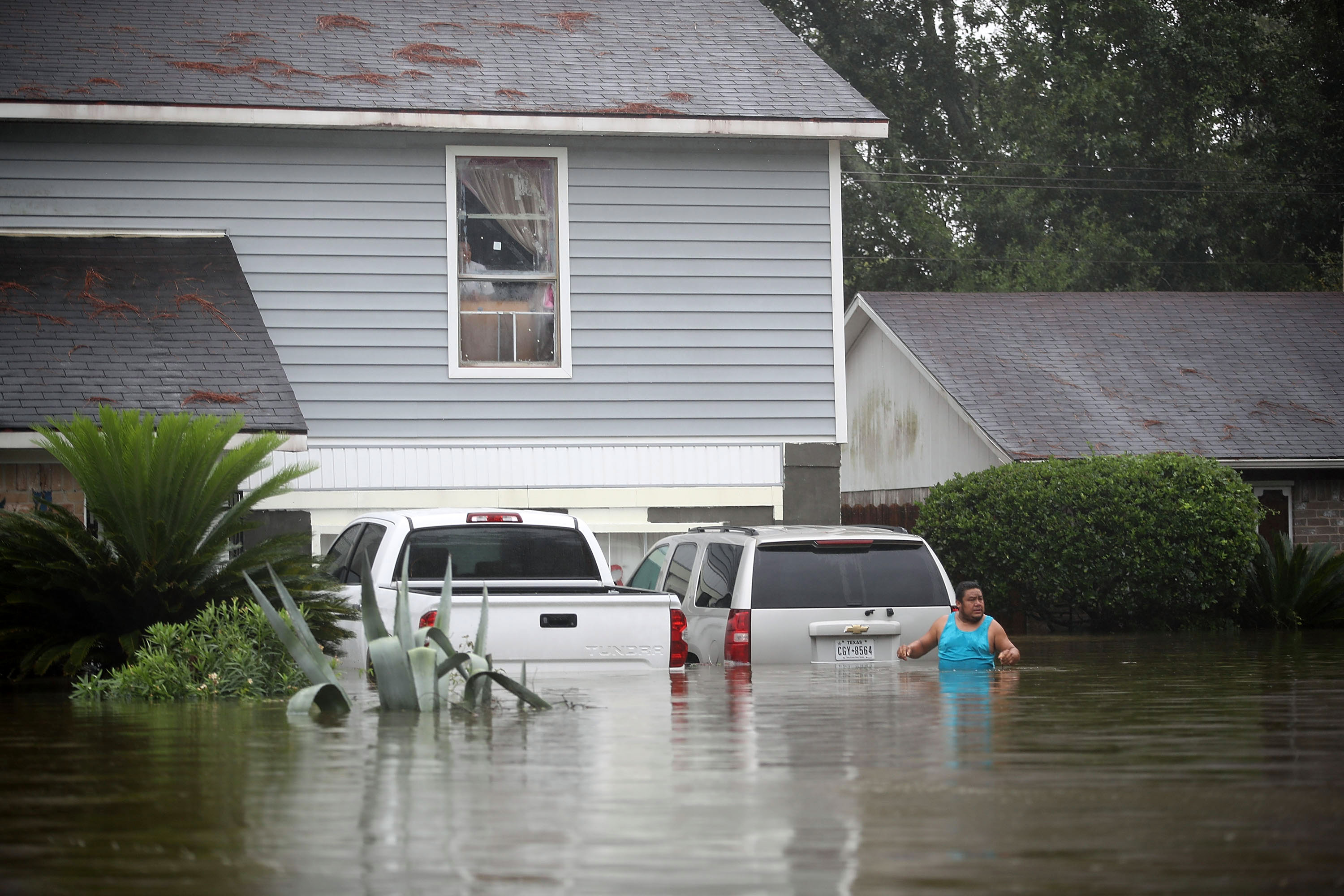The perverse incentives of the National Flood Insurance Program
How FEMA and the NFIP give builders and buyers financial encouragement to build on land best left alone


Much of Houston should not exist.
I say that not out of any malice for the Magnolia City, but as a simple statement of geographic fact. The east Texas boomtown — the fourth-largest city in the U.S., now in the midst of a horrific pummeling by Hurricane Harvey — is the product of decades of rapid-fire development in which home after home was built on flat, low-lying land with a propensity for flooding. Drainage is central to Houston's problems, for urban sprawl has engulfed and encased prairie land once far from the city center, replacing deep-rooted, absorbent native grasses on natural floodplains with impermeable paved surfaces. When water arrives — and arrive it will, as environmental changes now have once-in-a-lifetime storms like Hurricane Harvey hitting Houston several times a decade — it must go somewhere. When it cannot drain down, it will go up: up into your yard, your car, your living room, your books, your heirlooms, your life.
When I say that much of Houston should not exist, it is because it is constructed on dangerous and environmentally fragile land that should never have been used for permanent structures. So why does it exist? Why would the practical, fiscally conservative people of Texas anchor their financial security in houses that are now literally underwater?
The Week
Escape your echo chamber. Get the facts behind the news, plus analysis from multiple perspectives.

Sign up for The Week's Free Newsletters
From our morning news briefing to a weekly Good News Newsletter, get the best of The Week delivered directly to your inbox.
From our morning news briefing to a weekly Good News Newsletter, get the best of The Week delivered directly to your inbox.
There is no one answer, but a major culprit is the Federal Emergency Management Agency (FEMA), and specifically its subsidiary, the National Flood Insurance Program (NFIP). Together, FEMA and the NFIP have provided builders and buyers with bad information from a trusted source while offering financial encouragement to build on land best left alone. These programs have fostered the infrastructure arrangements that are magnifying the heartbreak in Houston this week. Well-meaning but drenched in perverse incentives, they are complicit in the horrifying destruction now racking the Texas gulf coast.
The NFIP offers flood insurance at steep discounts for homes and other buildings, including businesses, constructed in flood-prone areas. (Such insurance is a federal mandate to secure a mortgage in these zones.) Where a normal insurance company would jack up the premium price to cover the high risk of floodplain construction, thus discouraging vulnerable building plans among those who cannot afford to cover the cost of disaster, the NFIP will insure this construction at a discount.
This incentivizes risky construction and downplays the nature of the risk. After all, catastrophic insurance is essentially a wager in which the company bets disaster won't strike and the customer bets it will. Riskier wagers come at a higher price, so an artificially low premium like the NFIP offers cruelly deludes homeowners into believing their flood-prone houses are far safer than they are.
When it was introduced in 1968, the NFIP was cast as a necessary aid to Americans put in precarious financial situations because they could not afford flood insurance on the open market. But the NFIP's most significant effect is not offering respite for old construction put in new danger by a changing climate. Rather, the NFIP has taxpayers subsidizing unrealistically low premiums that incentivize new construction on dangerous land, and its discounts are available even to wealthy homeowners with pricey properties. "About 80 percent of NFIP households are in counties that rank in the top income quintile," notes a recent report at Politico, and "[w]ealthier households also tend to receive larger subsidies."
A free daily email with the biggest news stories of the day – and the best features from TheWeek.com
For example, journalist John Stossel, formerly of ABC News and Fox Business (and certainly not hurting for cash), recounted his own acquisition of NFIP insurance in a 2004 article entitled, "Confessions of a Welfare Queen." Stossel described building a large, four-bedroom beach house in an "absurd place," where all "that stood between my house and ruin was a hundred feet of sand."
Because "private insurers weren't dumb enough to sell cheap insurance to people who built on the edges of oceans or rivers," the only insurance available to Stossel was the NFIP. For just a few hundred dollars a year, the federal government insured his flood-prone home — indefinitely. "So if the ocean ate what I built, I could rebuild and rebuild again and again," Stossel wrote, as "there was no limit to the number of claims on the same property in the same location" and the NFIP would pay up to "$250,000 per house per flood."
Since Stossel's piece was published, taxpayers have covered the cost to rebuild the entire first floor of his beachfront home after predictable flooding — oh, and Congress bumped the per house per flood payment limit up to $520,000.
Needless to say, the NFIP is nowhere near solvent, because it is based on the fuzziest of math. The agency is $25 billion in debt, and superstorms like Hurricanes Katrina, Sandy, and now Harvey make its fiscal situation graver still. The NFIP simply does not charge enough to pay what it promises. As of 2012, the NFIP's total liability was $1.25 trillion, exceeded only by Social Security among federal liabilities. This program on which many Americans have bet their financial future is a ticking time bomb.
Making matters worse is how the NFIP determines which areas to insure. The program is based on FEMA maps of flooding patterns — maps that are often outdated and don't reflect drainage changes caused by recent construction or other environmental evolutions. As the New Orleans-based Coalition for Sustainable Flood Insurance once put it, this means Americans who "built where the government told them" later find out Washington gives bad, potentially life-ruining advice.
The one bright spot in all this is that the NFIP is coming up for reauthorization at the end of September, which means Congress has an opportunity to shutter this mess of perverse incentives before it does more damage. This would not be a popular decision, as even milder reforms that resulted in premium hikes via 2012's Flood Insurance Reform Act produced substantial backlash among NFIP customers. The reforms were mostly reversed.
Still, delaying major changes to flood insurance in America will only compound future suffering because of the NFIP's role in misrepresenting construction risks and thus promoting flood-prone development. "Homeowners and businesses should be responsible for purchasing their own flood insurance on the private market, if they can find it," argue Judith Kildow and Jason Scorse, economists at Middlebury College's National Ocean Economics Program, in The New York Times. "If they can't, then the market is telling them that where they live is too dangerous."
Axing the NFIP and transitioning back to private flood insurance, with its accurate risk signaling, is much overdue. It is neither ethical nor practical to maintain the current arrangement of government subsidies for real estate recklessness. Without 50 years of the NFIP, Houston would look very different right now.
Bonnie Kristian was a deputy editor and acting editor-in-chief of TheWeek.com. She is a columnist at Christianity Today and author of Untrustworthy: The Knowledge Crisis Breaking Our Brains, Polluting Our Politics, and Corrupting Christian Community (forthcoming 2022) and A Flexible Faith: Rethinking What It Means to Follow Jesus Today (2018). Her writing has also appeared at Time Magazine, CNN, USA Today, Newsweek, the Los Angeles Times, and The American Conservative, among other outlets.
-
 The biggest astronomy stories of 2025
The biggest astronomy stories of 2025In the spotlight From moons, to comets, to pop stars in orbit
-
 The 8 best comedy movies of 2025
The 8 best comedy movies of 2025the week recommends Filmmakers find laughs in both familiar set-ups and hopeless places
-
 ‘Care fractures after birth’
‘Care fractures after birth’instant opinion Opinion, comment and editorials of the day
-
 Bari Weiss’ ‘60 Minutes’ scandal is about more than one report
Bari Weiss’ ‘60 Minutes’ scandal is about more than one reportIN THE SPOTLIGHT By blocking an approved segment on a controversial prison holding US deportees in El Salvador, the editor-in-chief of CBS News has become the main story
-
 Has Zohran Mamdani shown the Democrats how to win again?
Has Zohran Mamdani shown the Democrats how to win again?Today’s Big Question New York City mayoral election touted as victory for left-wing populists but moderate centrist wins elsewhere present more complex path for Democratic Party
-
 Millions turn out for anti-Trump ‘No Kings’ rallies
Millions turn out for anti-Trump ‘No Kings’ ralliesSpeed Read An estimated 7 million people participated, 2 million more than at the first ‘No Kings’ protest in June
-
 Ghislaine Maxwell: angling for a Trump pardon
Ghislaine Maxwell: angling for a Trump pardonTalking Point Convicted sex trafficker's testimony could shed new light on president's links to Jeffrey Epstein
-
 The last words and final moments of 40 presidents
The last words and final moments of 40 presidentsThe Explainer Some are eloquent quotes worthy of the holders of the highest office in the nation, and others... aren't
-
 The JFK files: the truth at last?
The JFK files: the truth at last?In The Spotlight More than 64,000 previously classified documents relating the 1963 assassination of John F. Kennedy have been released by the Trump administration
-
 'Seriously, not literally': how should the world take Donald Trump?
'Seriously, not literally': how should the world take Donald Trump?Today's big question White House rhetoric and reality look likely to become increasingly blurred
-
 Will Trump's 'madman' strategy pay off?
Will Trump's 'madman' strategy pay off?Today's Big Question Incoming US president likes to seem unpredictable but, this time round, world leaders could be wise to his playbook
